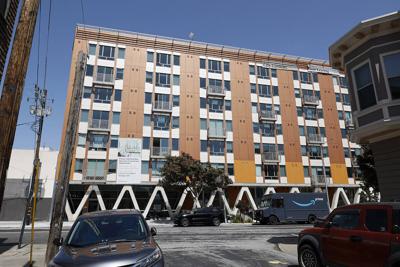Featured in the San Francisco Examiner:
San Francisco plans to purchase 200 units to house homeless families
‘The most vulnerable families need supportive housing’

The City is eyeing the Common City Gardens building at 333 12th St. to create 200 units for homeless families. (Craig Lee/The Examiner)
A sparkling seven-story building on 12th Street could soon play a key role in not only getting homeless families into housing, but helping them avoid displacement outside of San Francisco.
Earlier this month, Mayor London Breed announced The City’s plans to buy City Gardens, a residential building South of Market that would provide permanent supportive housing to families experiencing homelessness.
If the Board of Supervisors approves the deal, it would be the first building The City has purchased and dedicated exclusively to families under Breed’s plan to add 1,500 units of permanent supportive housing to The City’s growing portfolio by June.
It’s long overdue, according to advocates and service providers for homeless families. Permanent supportive housing is a model that ensures tenants an affordable place to live, for as long as they would like, coupled with an array of social services such as mental health treatment.
For many families, permanent supportive housing can be preferable to options like rapid rehousing, a different support that provides short-term financial help to a person or family experiencing homelessness so that they can find a new home in the private market.
Rapid rehousing is intended as a quick fix that steps in when someone has an unexpected major issue, such as loss of a job or medical event that results in homelessness. While effective at mitigating homelessness in the near term, rapid rehousing has unintended consequences, advocates for homeless families point out.
Mary Kate Bacalao, director of external affairs and policy at Compass Family Services, said rapid rehousing can amount to “state-subsidized displacement.”
Because the financial assistance is temporary, it’s possible they could find a place in San Francisco but would be unable to pay for it once the money runs out, risking homelessness over again.
This issue is well-documented in high-cost housing markets in San Francisco. In 2018, the San Francisco Public Press reported most families that received rapid rehousing assistance were moving to more affordable housing markets throughout the Bay Area.
Rapid rehousing clients can end up as far away as Sacramento, according to Kyriell Noon, CEO of Hamilton Families, a nonprofit like Compass that connects families with rapid rehousing support. The distance makes it difficult to stay engaged with clients and ensure they’re connected to support services, Noon said. And, because people of color are disproportionately in need of housing support, the consequences are especially dramatic, Noon said.
“Rapid rehousing inadvertently is hastening the exodus of Black and brown low-income folks out of The City,” Noon said.
Advocates say rapid rehousing has its place, but it’s not the best fit for everyone. “The most vulnerable families need supportive housing,” Bacalao said.
And yet, in the absence of adequate permanent supportive housing, it’s the most vulnerable families that rise to the top of the priority list and thus are directed into rapid rehousing, Bacalao said. That’s why The City’s purchase of the building at 333 12th St. would be pivotal.
There’s a communal lounge and laundry rooms on every floor, an outdoor courtyard and even a place to store bicycles.
The building won’t come cheap — the proposed deal totals $145 million — but it’s essentially brand new, opening just last year. And it could be ready for new tenants in a matter of months.
Built as a co-living space, where single rooms are rented out and tenants share common spaces like kitchens, it’s replete with 200 units that The City views as a good fit for families experiencing homelessness.
And in San Francisco, there are hundreds of such families, often invisible because they’re living in cars or crashing on couches.
According to the most recent Point-in-Time Count, the biennial census of The City’s homeless population, there were 208 homeless families in 2019.
Advocates warn the actual number is probably much higher, as the Point-in-Time Count uses the narrow definition of homelessness set by the federal department of Housing and Urban Development.
Still, the 200 new units of supportive housing would be a welcome start.
“It’s not perfect, but it’s great and I’ll take it,” Noon said.

No comments:
Post a Comment